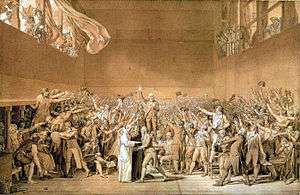Tennis Court Oath

On 20 June 1789, the members of the French Third Estate, who had begun to call themselves the National Assembly, took the Tennis Court Oath (French: Serment du Jeu de Paume), vowing "not to separate, and to reassemble wherever circumstances require, until the constitution of the kingdom is established". It was a pivotal event in the French Revolution.
The Estates-General had been called to address the country's fiscal and agricultural crisis, but immediately after convening in May 1789, they had become bogged down in issues of representation—particularly, whether they would vote by head (which would increase the power of the Third Estate, as they outnumbered the other two estates hugely) or by order.
On 17 June, the Third Estate, led by the comte de Mirabeau, began to call themselves the National Assembly.[1] On the morning of 20 June, the deputies were shocked to discover that the chamber door was locked and guarded by soldiers. Immediately fearing the worst and anxious that a royal attack by King Louis XVI was imminent, the deputies congregated in a nearby indoor jeu de paume court in the Saint-Louis district of the city of Versailles, near the Palace of Versailles.
There, 576 of the 577 members from the Third Estate took a collective oath "not to separate, and to reassemble wherever circumstances require, until the constitution of the kingdom is established".[2] The only person who did not join was Joseph Martin-Dauch from Castelnaudary, who would only execute decisions made by the king.[3]
Background
Before the Revolution, French society—aside from royalty—was divided into three estates. The First Estate comprised the clergy; the Second Estate was the nobility. The entire rest of France—some 98% of the population—was the Third Estate, which ranged from very wealthy city merchants to impoverished rural farmers. The three estates met from time to time in the Estates General, a legislative assembly.[4]
Although the Third Estate was the overwhelming majority of the French population, the makeup of the Estates General was such that the Third Estate comprised a bare majority of the delegates. A simple majority was sufficient—as long as the delegates' votes were cast altogether. The First and Second Estates preferred to divide the vote in some way. A proposal might need to receive approval from each Estate, or there might be two "houses" of the Estates General (one for the first two Estates, and one for the Third), and a bill would need to be passed by both houses. Either way, the First and Second Estates could exercise veto power over proposals enjoying widespread support among the Third Estate, such as reforms that threatened the privileges of the nobility and clergy.
In France at that time, the deputies' fears, even if wrong, were reasonable and the importance of the oath goes above and beyond its context.[5]
The oath was both a revolutionary act, and an assertion that political authority derived from the people and their representatives rather than from the monarch himself. Their solidarity forced Louis XVI to order the clergy and the nobility to join with the Third Estate in the National Assembly in order to give the illusion that he controlled the National Assembly.[1] This oath would prove vital to the Third Estate as a step of protest that would eventually lead to more power in the Estates General, and every governing body thereafter.[6]
The Oath signified for the first time that French citizens formally stood in opposition to Louis XVI, and the National Assembly's refusal to back down forced the king to make concessions. It was foreshadowed by, and drew considerably from, the 1776 United States Declaration of Independence, especially the preamble. The Oath also inspired a wide variety of revolutionary activity in the months afterwards, ranging from rioting across the French countryside to renewed calls for a written French constitution. Likewise, it reinforced the Assembly's strength and forced the King to formally request that voting occur based on head, not power. The Tennis Court Oath (June 1789) preceded the abolition of feudalism (4 August 1789) and the Declaration of the Rights of Man and Citizen (26 August 1789).
References
- 1 2 Doyle, William (1990). The Oxford History of the French Revolution. Oxford University Press. p. 105. ISBN 978-0192852212.
- ↑ Thompson, Marshall Putnam (1914). "The Fifth Musketeer: The Marquis de la Fayette". Proceedings of the Bunker Hill Monument Association at the annual meeting. p. 50. Retrieved 10 February 2011.
- ↑ Hanson, Paul R. (2004). Historical Dictionary of the French Revolution. Lanham, MD: Scarecrow Press. ISBN 9780810850521.
- ↑ Estates-General in Encyclopædia Britannica
- ↑ Osen, James L. (1995). Royalist Political Thought during the French Revolution. Westport, CT: Greenwood Publishing Group. ISBN 9780313294419.
- ↑ John D Ruddy (2015-01-12), French Revolution in 9 Minutes, retrieved 2016-02-29
External links
